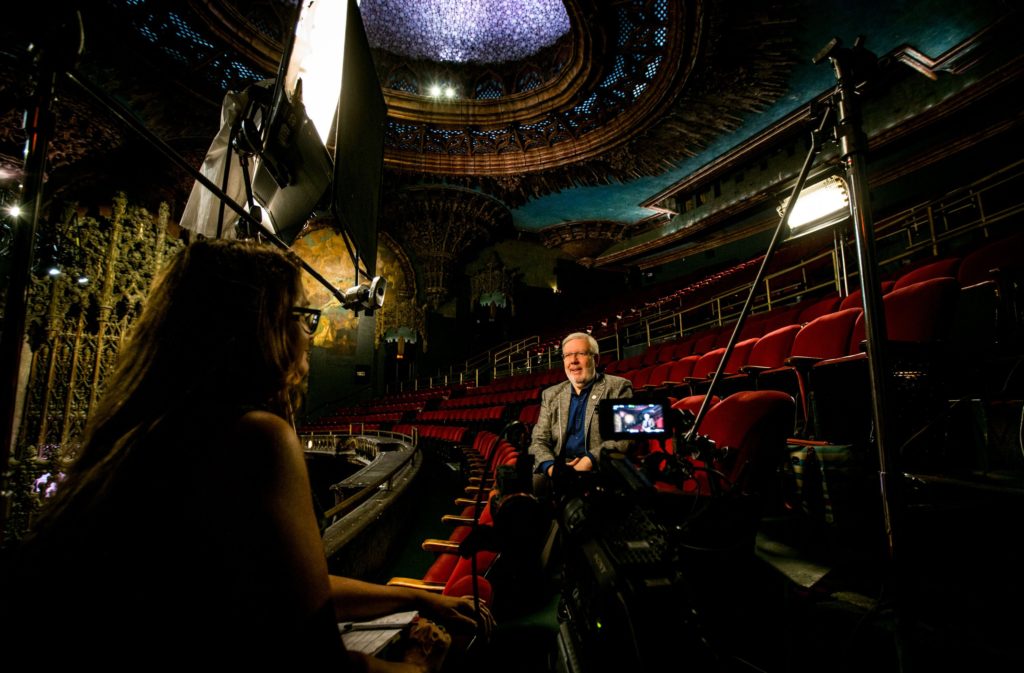“Going Attractions: The Definitive Story of the Movie Palace,” from writer-director April Wright, is a loving documentary celebrating cinema and movie houses. Movie palaces were ornate, opulent theaters that showed films from circa 1910 through WWII. “Going Attractions” looks at the rise of movie palaces, from the beginning of filmmaking and distribution through nickelodeons, their importance to the studio system, their decline, and current preservation efforts.
By talking with various film historians, historical societies and preservationists, and theater owners or past employees, Wright brings to life the history of the movie palace. With the invention of film came the need to distribute. First, they were shown via “peep show” machines and projected at vaudeville theaters, then at five-cent “nickelodeon” theaters, which were small, converted storefronts. The popularity of film, and decline of vaudeville, gave way to the rise of large, lavish movie houses.
They flourished in cities like New York, Chicago, and Los Angeles. This was in part due to the studio system, which often provided a direct line between production, distribution, and exhibition. MGM, for instance, had a such connection to the Loews theater.
The documentary not only focuses on the business aspects of movie palaces, but spends much time on the architecture of the buildings themselves — their sculptures, paintings, and art deco signage. Both the exteriors and interiors were works of art, and for some, the buildings (or their complimentary air conditioning) were more of a draw than the actual movies.
Patrons of movie palaces were treated like royalty. Everyone had to buy a ticket, so everyone was treated well, regardless of class. This was just another aspect that brought in the crowds.
The decline of the movie palace began in the 1940s. People started moving to the suburbs, television was introduced, and The Paramount Decrees ended the practice of movie studios owning their own theaters, ending guaranteed distribution to the public.
As the theaters went out of business, the properties often became damaged, or were sold off and demolished. The 1970s saw more efforts to preserve these irreplaceable buildings, and that’s why many of the facades still exist today. Several were also given to churches to fix up and use, while many theater owners still work on restoring the movie palaces to their former glory, and exhibit classic films for new audiences.
“Going Attractions” does a great job of showing how exciting movie palaces had been, but because most do not not exist today, or at least not in their original state, there is a melancholic undercurrent throughout the movie. Film historian Leonard Maltin sums up his support of preservation efforts and keeping theaters in use by noting, “Once you tear it down, you can’t rebuild it. Once it’s gone, it’s gone.”
Upcoming Screenings:
- December 6-9 — Continental Cinemas — Troy, AL
- December 6-12 — Gateway Film Center — Columbus, OH
- December 7, 28 — Luna Theater — Lowell, MA
- December 9 — Nelson Atkins Museum — Kansas City, MO
- December 13 — Cinema Worcester — Worcester, MA
- December 13-19 — Capitol Theatre — Olympia, WA
- December 14, 18 — Liberty Theater — Camas, WA
- December 20-26 — Mayfair Theatre — Ottawa, Ontario, Canada
Keep an eye on the film’s official website for added screenings.
Published monthly, Under the Radar offers a chance for us to highlight works by and/or about women that haven’t received big releases or significant coverage in the press, but are wholly worthy of attention.
To recommend a title for this feature, please e-mail womenandhollywoodinterns@gmail.com.







